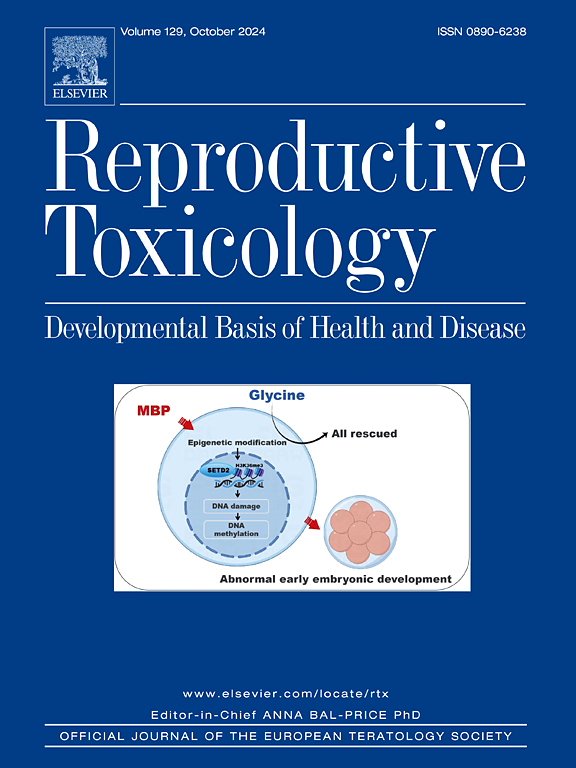Prenatal exposure to an environmentally relevant phthalate mixture alters oxidative stress, apoptosis, cell cycle regulators, and steroidogenic factors in the ovaries of F1 mice
IF 3.3
4区 医学
Q2 REPRODUCTIVE BIOLOGY
引用次数: 0
Abstract
Phthalates are synthetic chemical compounds found in consumer products and known endocrine-disrupting chemicals. However, it is not well known if prenatal exposure to phthalate mixtures can affect reproductive health in female offspring. Thus, this study tested the hypothesis that prenatal exposure to an environmentally relevant phthalate mixture disrupts long-term ovarian function in adult F1 mice. Pregnant CD-1 dams were dosed orally with vehicle control (corn oil) or phthalate mixture (20 μg/kg/day-500 mg/kg/day) from gestational day 10 until birth. After birth, the F1 female ovaries and sera were collected on postnatal day (PND) 60, 3 months, and 6 months. F1 ovaries were used for evaluation of the proliferative marker, Ki67, and to quantify gene expression of steroidogenic regulators, antioxidant enzymes, apoptotic factors and cell cycle regulators. Sera were collected to measure sex steroid hormone levels. At PND60, prenatal exposure to the mixture decreased the expression of Star, Cyp11a1, Bad, and Casp3 in F1 females at PND60 compared to controls. At 3 months, the mixture decreased expression of Cyp11a1, Hsd3b1, Sod1, Casp3, Casp8, and Fas and increased gene expression of Star and Gpx in F1 ovaries compared to the controls. At 6 months, the mixture decreased testosterone levels and expression of Gsr, Bad, Bok, Casp8, Fas and Traf3, and it increased expression of Star in F1 females compared to the controls. Collectively, these data suggest that the prenatal exposure to an environmentally relevant phthalate mixture may have long-term consequences on ovarian health and function in F1 females long after initial exposure.
产前暴露于环境相关的邻苯二甲酸盐混合物会改变F1小鼠卵巢中的氧化应激、细胞凋亡、细胞周期调节因子和类固醇生成因子。
邻苯二甲酸盐是一种合成化合物,存在于消费品和已知的干扰内分泌的化学物质中。然而,产前接触邻苯二甲酸盐混合物是否会影响女性后代的生殖健康,目前尚不清楚。因此,本研究验证了一种假设,即产前暴露于环境相关的邻苯二甲酸盐混合物会破坏成年F1小鼠的长期卵巢功能。从妊娠第10天至出生,给怀孕的CD-1母鼠口服对照剂(玉米油)或邻苯二甲酸酯混合物(20μg/kg/day-500 mg/kg/day)。出生后,分别于产后60个月、3个月和6个月采集F1雌性卵巢和血清。利用F1卵巢检测增殖标志物Ki67,并定量测定促甾体生成调节因子、抗氧化酶、凋亡因子和细胞周期调节因子的基因表达。采集血清测量性类固醇激素水平。在PND60时,与对照组相比,产前暴露于混合物降低了PND60时F1雌性中Star、Cyp11a1、Bad和Casp3的表达。在3个月时,与对照组相比,混合物降低了F1卵巢中Cyp11a1、Hsd3b1、Sod1、Casp3、Casp8和Fas的表达,增加了Star和Gpx的基因表达。在6个月时,与对照组相比,混合物降低了F1雌性的睾酮水平和Gsr、Bad、Bok、Casp8、Fas和Traf3的表达,并增加了Star的表达。总的来说,这些数据表明,产前暴露于与环境相关的邻苯二甲酸盐混合物可能对F1雌性在最初暴露后很长时间内的卵巢健康和功能产生长期影响。
本文章由计算机程序翻译,如有差异,请以英文原文为准。
求助全文
约1分钟内获得全文
求助全文
来源期刊

Reproductive toxicology
生物-毒理学
CiteScore
6.50
自引率
3.00%
发文量
131
审稿时长
45 days
期刊介绍:
Drawing from a large number of disciplines, Reproductive Toxicology publishes timely, original research on the influence of chemical and physical agents on reproduction. Written by and for obstetricians, pediatricians, embryologists, teratologists, geneticists, toxicologists, andrologists, and others interested in detecting potential reproductive hazards, the journal is a forum for communication among researchers and practitioners. Articles focus on the application of in vitro, animal and clinical research to the practice of clinical medicine.
All aspects of reproduction are within the scope of Reproductive Toxicology, including the formation and maturation of male and female gametes, sexual function, the events surrounding the fusion of gametes and the development of the fertilized ovum, nourishment and transport of the conceptus within the genital tract, implantation, embryogenesis, intrauterine growth, placentation and placental function, parturition, lactation and neonatal survival. Adverse reproductive effects in males will be considered as significant as adverse effects occurring in females. To provide a balanced presentation of approaches, equal emphasis will be given to clinical and animal or in vitro work. Typical end points that will be studied by contributors include infertility, sexual dysfunction, spontaneous abortion, malformations, abnormal histogenesis, stillbirth, intrauterine growth retardation, prematurity, behavioral abnormalities, and perinatal mortality.
 求助内容:
求助内容: 应助结果提醒方式:
应助结果提醒方式:


